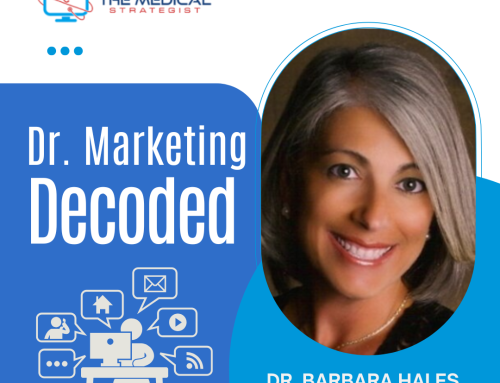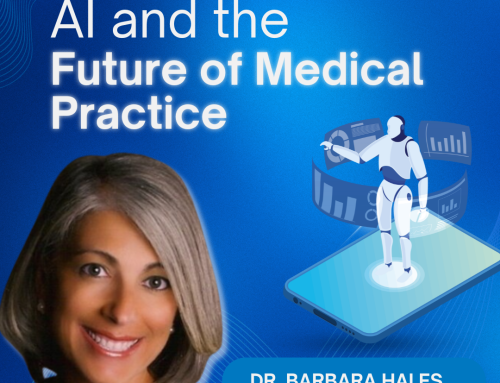Podcast: Play in new window | Download
Subscribe: RSS
In this episode, Barbara and Lawrence Cazan Cassini discuss:
- The evolution of Lawrence’s career in the wellness and preventative health sector.
- The development of a new biomarker scanner used to measure levels of antioxidants in skin cells.
- How knowing a patient’s antioxidant absorption can help tailor a diet specific to their needs.
Key Takeaways:
- 70% of non-communicable diseases are preventable through better nutrition.
- Discussing nutrition with your patients as an untapped marketing angle.
- Preventative health care is the future of medicine.
“Around the United States is a tsunami beginning right now, which is in this preventive medicine field.” — Lawrence Cazan Cassini
Transcription
Barbara Hales: Welcome to another episode of Marketing Tips for Doctors. Today we’re lucky to have with us Lawrence Cazan Cassini. He is originally from Rhodesia, and is a successful top-level executive originally to an international tobacco corporation for many years. He traveled internationally through 20 countries in South America, Europe, Asia, North America, and Australia. He is fluent in Spanish, Portuguese, Italian, French, English, and two African dialects.
Despite his many business successes, a traumatic event forced him to re-evaluate his priorities in life. As a result, Mister Cassini has been devoted to alternative and complimentary health and preventive care since 1984 including Reiki, nutrition, and mind/body techniques. He opened a wellness center contracting several therapists as well as establishing an organic food café.
Six years later he was introduced to innovative science and technology, which allowed him to validate what he knew to be true all along about nutrition. With this technology and the backing of a 34 year old company with nearly 80 resident scientists Lawrence sold his wellness center, and now works with teams in several countries. His primary focus is with healthcare professionals, pharma and medical sales reps with particular emphasis on preventative medicine.
Lawrence welcome to the show.
Lawrence Cassin: Thank you.
Barbara Hales: It’s a pleasure having you here. Tell me how do you work with practicing physicians? I understand that you’re representing Pharmanex. How do you help them? And, by the way, the reason for this talk today for marketing tips for doctors is two-fold. As physicians, you should be showing your patients that you are concerned about their nutrition, and secondly by doing so it is great marketing ploy because a lot of your competitors are not doing so. So, tell me, Lawrence, how do you work with practicing physicians?
Lawrence Cassin: Consider that about 70% of non-communicable diseases are preventable, such as cardiovascular disease, hypertension, diabetes type two, lots of cancers. For those 70% of non-communicable diseases that are preventable the common denominator is nutrition, generally speaking. I’m not trying to over simplify it, but generally it’s a question of nutrition. And, yet, we spend 80% of our healthcare budget trying to fix what’s preventable, which is totally incongruent. It’s ridiculous.
So, when you consider that the doctors do their best with what they know, which is pharmaceutical based evidence according to their studies, and yet we can understand that a lot of the diseases that are being treated are preventable. And if the doctors just were able to have recourse to show and be able to test and measure some biomarker that was possible for them to identify at least one of the important elements, which is the level of antioxidants, which are your defenses against free radicals that cause oxidative stress.
Barbara Hales: Lawrence how is that tested in people?
Lawrence Cassin: So, the reason I was very attracted to this company was because it’s a way that I was able to validate what I know about nutrition. I was able to help the people that came to my center, and to my organic café that I was able to test and measure and show them that the results of their nutritional habits are reflected in at least one of the biomarkers that we could identify. And the device was developed by the University of Utah, funded by the National Institute of Health, and it uses a technology that won the Nobel prize for science, which is called Raman spectroscopy, which measures your level of antioxidants through the carotenoid in the cells of your skin.
By having a device, which is technically noninvasive, where you can measure in real time one of these biomarkers, and the patient then sees a result on a screen, which is not just a number. If you say to the patient, “Your cholesterol is 300,” it doesn’t mean anything. I mean, of course it means, but, I mean, to the patient it’s just a number. Whereas if you show them on a screen the level of their antioxidant defenses it’s more impactful, and they can see and make some decisions on that.
So, the device, for me, was something that was a window to preventive medicine, and a way which we could use the scientists of the company, which you mentioned, approximately close to 80 of them, 35 PhDs, 14 modalities. Those give us the passport to the future, which is science, technology and innovation. So, if we can marry preventive medicine to science, technology and innovation, and we can look at the future I think this is very, very encouraging.
Barbara Hales: Could you tell us, is this machine portable, and how does this work to screen patients for their antioxidants?
Lawrence Cassin: Sure. So, the interesting thing about this is that the device was, as I said, developed by the University of Utah, but was the size almost of a ping-pong table. And when the company saw this, and they saw the merits of … First of all, they understand that it was developed to measure macular degeneration in the eye, and they asked how, and they said, “Through the carotenoids.” And they understood that the carotenoids is the largest family of antioxidants, and they are sort of the foot soldiers of the antioxidants. They saw that, and they saw the merits of that, and they thought, “Wow. If we can measure the absorption of carotenoids or antioxidants in the body, and there is a link with nutrition we have really got something interesting.” So, they purchased the rights of the device from the University of Utah for, I believe, about 10 million dollars. And then they spent another, approximately, 100 million dollars to downsize it from the size of a ping-pong table to the size of a small football for physicians use.
And the device, actually, is in the doctor’s clinics, but it doesn’t have to be handled by a specialist. Any assistant in the office can do it. And the products that the company recommends thereafter to strengthen the level of antioxidants are actually listed in the PDR as well.
Barbara Hales: Well, that’s very impressive. Could you tell us what some of those nutritional supplements are?
Lawrence Cassin: Well, the interesting thing is that the company and Pharmanex had products in 38,000 pharmacies around the country. Pharmanex was actually founded by one of the founders was Joe Chang who was one of the chief scientists at Wyeth Laboratories, and he was instrumental in developing Rapamune, one of the antirejection drugs for transplant organs. And one of the other founders was another Chang, not related, that developed the product called Colistin.
And the third one was Carl Djerassi, who was instrumental in developing the oral birth control pill. So, they had their products in 38,000 pharmacies, and they realized they were spending a lot of money on advertising, and paying the pharmacy to put their product at eye level instead of at foot level. So, they realized that they believed their products were really, really good so does everybody else believe that their products are really, really good. So, when they believe their products are very, very good everybody does.
But how do you test and measure and prove it? So, they also wanted to market their products in a more efficient way rather than just waiting for some technician in a pharmacy to advise a customer about a product. So, they train their distributors, such as myself, to do one-on-one with the physicians. And the reason they did that was because they wanted to be able to show that the products are really, really good, and they wanted to be able to test and measure them, and hence the scanner was purchased. And the products have actually got something, which I think is very interesting, which is that they have a component, many of them, that is called age lock, which is in the oral side as well as the topical side. Age lock actually helps to reset up to 1,000 genes in each cell to a youthful expression via the mitochondrias.
So, we’re starting to see that the oral products, that is ingredient as a platform of technology, in some of these supplements that we have are able to help the genes reset to a youthful expression, which means that we can help people with memory, and energy, and sexual libido, and hepatic support, and renal support, and cardiovascular support, and so on. And these products can actually be measured on the scanner.
Barbara Hales: So, how can the typical practicing physician get a hold of these scanners?
Lawrence Cassin: Well, the scanner is distributed by distributors. The company does not distribute the scanners. It’s only by the distributors. And usually this is by reference or referral from one doctor to the other. We are also present in a lot of the events, a lot of the expos, and we have distributors throughout the United States that are able to, or that, have a group of doctors where they have the scanners.
Barbara Hales: Well, this is really exciting that doctors can make a difference by shifting the paradigm from disease management to health optimization.
For our listeners today, Lawrence, tell us how they could find distributors. For instance, should they contact you, and if so how do they get in touch with you?
Lawrence Cassin: Well, I’d be happy to do that. I’m in Florida. I’m in South Florida in Pembroke Pines. My e-mail is LawrenceCazan@gmail and my number is 954-614-6540. And we actually have physicians in pretty well most of the states around the United States. There’s a tsunami beginning right now, I believe, which is in this preventive medicine field because the physicians have understood that the answers are more than just pharmaceutical based solutions. Those are very good, but those should be the last resort if any. So, around the United States we’ve got less than 2,000 scanners right now, and we’re at the beginning of a tsunami in this preventive medicine field.
Barbara Hales: So, listeners just realize that you would be on the ground floor, and your patients would see that you are on the cutting edge, and that you are a thought leader in your field.
I’d also like you to know that there are preventive medicine healthcare symposiums, which are located in Provo, Utah. Could you tell us about that for a moment?
Lawrence Cassin: So, each month the company gets together a group of scientists and a group of physicians and a group of pharma medical sales reps, and we have a preventive medicine healthcare symposium at the company headquarters, which allows all of the participants to see for themselves the laboratories, meet some of the scientists, get all of the cobwebs about their own apprehensions, or their own questions out of the way about whatever they may have in terms of healthcare uncertainties or questions. And it’s a way for the physicians to have, what I like to joke about and say, scientific indigestion because once all the questions are answered, and they know they’ve had all of their questions, then we show them how to apply the device and the system into their practices on a daily basis to be able to help their patients make educated lifestyle choices, and help them make money. And so, we have that every month.
Barbara Hales: That’s great. Well, Lawrence represents MD Solutions, and you could reach him at LawrenceCazan@gmail.com.
Thank you so much for being a guest on our show today.
Lawrence Cassin: Well, thank you. I’m very honored, and I am very encouraged for the work you are doing in the healthcare industry. I think it’s important, in fact, essential that we start thinking out of the box and looking at what is happening with our healthcare industry, which is actually at the crux of it’s a sick care society right now. So, what you are doing is a great job, I think, and I applaud you for it because we have to start looking at new directions rather than just doing the same old, same old, which is obviously not working.
Barbara Hales: Okay. Well, that concludes this episode. Thank you so much for listening. This has been your host Dr. Barbara Hales. Until next time.
Connect with Lawrence Cazan Cassini:
Email: LawrenceCazan@gmail.com
Phone: 954.614.6540
Connect with Barbara Hales:
Twitter: @DrBarbaraHales
Facebook: facebook.com/theMedicalStrategist
Business website:www.TheMedicalStrategist.com
Show website: www.MarketingTipsForDoctors.com
Email: Barbara@TheMedicalStrategist.com
Books:
YouTube: TheMedicalStrategist
LinkedIn: www.linkedin.com/in/barbarahales



